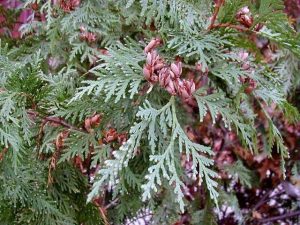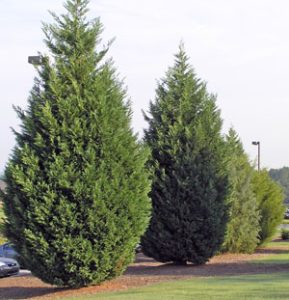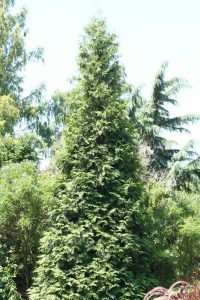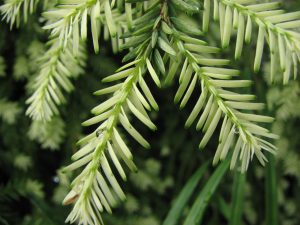Selecting Conifers for Landscape Screening
Part 1: Arborvitae, Cryptomeria and Hemlock
By Elaine Pugh, Fairfax Master Gardener

Thuja occidentalis, American Arborvitae
With more people spending time outside year-round, you may have noticed areas of your yard that could use some additional screening. One way to do this is to add conifers, commonly known as narrow-leafed or needled evergreens.
A conifer screen of trees or large shrubs can create privacy, block unsightly views, define areas, act as a barrier and help control noise from adjacent highway traffic and other sources. In addition, a screen may also help block the harsh winter winds blowing into your property (usually from the northwest in our area) and create energy savings.
Arborvitae, cryptomeria, hemlocks, pines, and junipers are examples of conifers with tree or tall shrub forms suitable for evergreen screening in our area. But how should you choose which to use? Let’s compare them in terms of size, soil and sun requirements.

Leyland Cypress
Leyland cypress, xHesperotropsis leylandii, previously known as Cupressocyparis leylandii, is a fast-growing pyramidal tree that grows to a height of 60 to 70 feet (18 – 20m) and a spread of 12 to 15 feet (3 – 4m). It tolerates a variety of soil types and requires full sun. Leyland cypress is a popular tree that has been overplanted and develops a number of problems, including canker and root rot which are incurable, so other alternatives are recommended.
Two Thuja arborvitae varieties are good for screening in Virginia. They can be used as a windbreak and pruned as a hedge. The foliage has a pleasant fragrance when crushed.
American arborvitae Thuja occidentalis is a slow-growing conical to narrowly pyramidal conifer reaching 20 to 30 feet in height (6 – 9m) with a spread of 10 to 15 feet (3 – 5m). Its needles are in flattened sprays and its cones are 1/3 to 1/2 inch long (8 – 12mm). T. occidentalis tolerates clay soil, prefers moist soil and is tolerant of limestone soils. Once established, it can tolerate drought. T. occidentalis prefers full sun and does not tolerate heavy shade. Bagworms can be a problem.

Thuja arborvitae ‘Green Giant’
Thuja arborvitae ‘Green Giant,’ previously known as Thuja plicata ‘Green Giant,’ is a fast growing cultivar reaching 40 to 60 feet in height (12 – 18m) with a 12 to 20 feet spread (3.5 – 6m). ‘Green Giant’ arborvitae is a cross between T. plicata and T. standishii. It is more shade tolerant than T. occidentalis, taking full sun or partial shade, and can tolerate more moisture in the soil. It resists most diseases, insects and periodic drought, and is less palatable to deer. Thuja ‘Green Giant’ is another recommended alternative for Leyland cypress.
Japanese cryptomeria Cryptomeria japonica has a pyramidal, graceful habit and grows 50 to 60 feet in height (15 – 18 m) with a spread of 20 to 30 feet (6 – 9m). Its awl-shaped fragrant needles are soft to the touch, and its cones are 1/2 to 1 inch in length (12 – 25cm). It is a suggested alternative to Leyland cypress. It is fast growing and prefers a rich and deep, light, permeable, acid soil with abundant moisture. C. japonica prefers an open sunny location, but will tolerate some shade, and needs protection from high wind. ‘Yoshino’ is a well-known cultivar.

Tsuga canadensis, Eastern or Canadian Hemlock
Canadian hemlock Tsuga canadensis is a large, graceful conical-shaped tree with flat scale-like foliage and cones 1/2 to 1 inch in length (12 – 25cm). It can grow 40 to 70 feet (12 – 21m) in height by 25 to 30 feet (7 – 9m) in spread and can be sheared as a hedge. It prefers moist, well-drained acidic soil. One of its main benefits is that it tolerates shade well, but also grows in full sun. T. canadensis needs wind protection. Its main drawback is a pest called wooly adelgid, a cottony-looking mite, which can be controlled with horticultural oil or with a systemic pesticide applied by a certified arborist.
Next month, in Part 2 of our series on Selecting Conifers for Landscape Screening, we will describe appropriate pines and junipers and will provide planting guidelines.
Resources
• Manual of Woody Landscape Plants, by Michael A. Dirr
• Home Grounds and Animals, 2021 Pest Management Guide, Table 8.2 – Ornamental plants less
palatable to deer
• Screening, Bonnie Appleton, Elizabeth Baine, Roger Harris, Kathy Sevebeck, Dawn Alleman and
Lynette Swanson, Virginia Cooperative Extension, Publication 430-025
• Selecting Landscape Plants: Conifers, Diane Relf, and Bonnie Appleton, Virginia Cooperative
Extension, Publication 426-605
• Climatic Wind Data for the United States, National Climatic Data Center
• Screening with Evergreens, Mary Morgan Arrington, updated by Sam Lusk, North Carolina
Cooperative Extension, Wilkes County Center
• Using Trees and Shrubs for Privacy and Wind Screening, Emelie Swackhamer and Jim Sellmer, Penn
State Extension
• Cryptomeria japonica, Missouri Botanical Garden Plant Finder
• Thuja ‘Green Giant,’ Tsuga canadensis and xHesperotropsis leylandii, North Carolina State Garden
Toolbox
• Tsuga canadensis, Alex Niemiera, Virginia Cooperative Extension, Pub 3010-1465